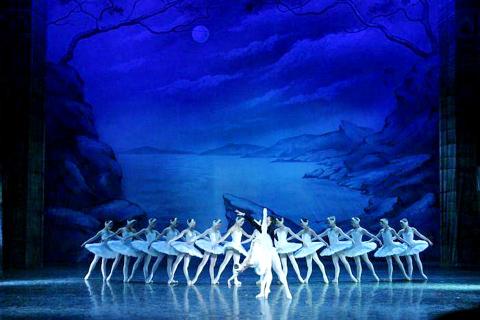The Moscow City Ballet’s swans have returned to Taipei for five shows at the National Theater.
At 27, the company is still a babe compared to its more famous Russian counterparts, the Mariinsky and Bolshoi ballet companies, but it has established a name for itself with competent, if somewhat stodgy, productions of the romantic classics, and its dancers come from state-runs schools in Russia and former Soviet states such as Ukraine.
The private company — a rarity in the Russian ballet world — was founded by former Bolshoi dancer-turned-choreographer Victor Smirnov-Golovanov, who died two years ago. His widow, Ludmila Nerubashenko, a former soloist with the company, is now artistic director.

Photo courtesy of moscow city ballet
The troupe’s strength is in its well-disciplined corps de ballet, crucial if you are sticking to the classics that need flocks of swans, Willies, village maidens or snowflakes who often have to perform two shows a day, as they will tomorrow and Sunday. The principal’s roles are often overshadowed by the mishmash of choreography they are expected to execute, combining the original Lev Ivanov-Marius Petip footwork with additions by Smirnov-Golovanov or other Russian choreographers.
One of the unique features of Smirnov-Golovanov’s production of Swan Lake is Odile’s half-black, half-white tutu that highlights the duality of her role, as she shows the white side to the prince, but the black to the audience.
Taiwanese ballet fans who cannot get enough of Swan Lake would appear to be in luck, as another frequent visitor to these shores, the Russian Festival Ballet, is coming next month with Swan Lake, The Nutcracker and Romeo and Juliet. However, the Moscow City Ballet’s production has better sets and staging.

Photo courtesy of mowcow city ballet
■ Tonight at 7:30pm, tomorrow at 2:30pm and 7:30pm and Sunday at 1pm and 6:30pm, National Theater (國家戲劇院), 21-1 Zhongshan S Rd, Taipei City (台北市中山南路21-1號)
■Tickets are NT$400 to 3,800, available online at www.kham.com.tw or at convenience store ticket kiosks

Taiwan doesn’t have a lot of railways, but its network has plenty of history. The government-owned entity that last year became the Taiwan Railway Corp (TRC) has been operating trains since 1891. During the 1895-1945 period of Japanese rule, the colonial government made huge investments in rail infrastructure. The northern port city of Keelung was connected to Kaohsiung in the south. New lines appeared in Pingtung, Yilan and the Hualien-Taitung region. Railway enthusiasts exploring Taiwan will find plenty to amuse themselves. Taipei will soon gain its second rail-themed museum. Elsewhere there’s a number of endearing branch lines and rolling-stock collections, some

The Democratic Progressive Party (DPP), Chinese Nationalist Party (KMT), and the country’s other political groups dare not offend religious groups, says Chen Lih-ming (陳立民), founder of the Taiwan Anti-Religion Alliance (台灣反宗教者聯盟). “It’s the same in other democracies, of course, but because political struggles in Taiwan are extraordinarily fierce, you’ll see candidates visiting several temples each day ahead of elections. That adds impetus to religion here,” says the retired college lecturer. In Japan’s most recent election, the Liberal Democratic Party lost many votes because of its ties to the Unification Church (“the Moonies”). Chen contrasts the progress made by anti-religion movements in

Could Taiwan’s democracy be at risk? There is a lot of apocalyptic commentary right now suggesting that this is the case, but it is always a conspiracy by the other guys — our side is firmly on the side of protecting democracy and always has been, unlike them! The situation is nowhere near that bleak — yet. The concern is that the power struggle between the opposition Chinese Nationalist Party (KMT) and their now effectively pan-blue allies the Taiwan People’s Party (TPP) and the ruling Democratic Progressive Party (DPP) intensifies to the point where democratic functions start to break down. Both

This was not supposed to be an election year. The local media is billing it as the “2025 great recall era” (2025大罷免時代) or the “2025 great recall wave” (2025大罷免潮), with many now just shortening it to “great recall.” As of this writing the number of campaigns that have submitted the requisite one percent of eligible voters signatures in legislative districts is 51 — 35 targeting Chinese Nationalist Party (KMT) caucus lawmakers and 16 targeting Democratic Progressive Party (DPP) lawmakers. The pan-green side has more as they started earlier. Many recall campaigns are billing themselves as “Winter Bluebirds” after the “Bluebird Action”